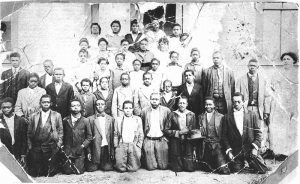calsfoundation@cals.org
Taking a New Stand on the EOA’s County Histories
 I started reading Stephen King in junior high school, but I didn’t get around to his 1978 book The Stand before he released an expanded version, with more than 400 additional pages, in 1990. I imagine many an author has been tempted to go back and revisit an earlier work and really spruce it up or return to life all those passages a more market-oriented editor insisted be left behind, but only King had the cultural heft to make his desire a printed reality. The expanded version was the only one I ever read, so I have no idea whether his was a good idea, although it sold well enough, to be sure, and is the version fans generally consider canonical. Many of my book purchases at the time were predicated by a dollar-to-pages ratio, and on that front, the expanded version was the better buy.
I started reading Stephen King in junior high school, but I didn’t get around to his 1978 book The Stand before he released an expanded version, with more than 400 additional pages, in 1990. I imagine many an author has been tempted to go back and revisit an earlier work and really spruce it up or return to life all those passages a more market-oriented editor insisted be left behind, but only King had the cultural heft to make his desire a printed reality. The expanded version was the only one I ever read, so I have no idea whether his was a good idea, although it sold well enough, to be sure, and is the version fans generally consider canonical. Many of my book purchases at the time were predicated by a dollar-to-pages ratio, and on that front, the expanded version was the better buy.
There are a few other examples of artists revisiting and revising earlier works. Japanese animator Hideaki Anno created the series Neon Genesis Evangelion, which aired in 1995 and 1996, and then provided an alternate ending to the story with two movies released in 1997. And then, ten years later, he released the first of four movies retelling the story of his original series, with completely new characters and a different conclusion. Here, the intention wasn’t to restore to life something left behind but to tell roughly the same story from a more mature and considered perspective, and so on this front, opinions are a little more divided, as many of us who watched the initial series upon its release identified rather deeply with the raw emotions and existentialism it offered. In some cases, revision can seem like heresy, even when undertaken by the original creator.
Of course, some people approach the field of history with the same attitude, desiring to preserve the feelings they experienced when younger, suspicious of anyone who might tell the story differently. But that is a subject for another time. For the moment, let’s leave behind the subject of revisionist history and stick to the matter of expanding it, because that’s part of what we’ve done this year at the CALS Encyclopedia of Arkansas—expand the history we offer.
Granted, with every new entry we add, we are expanding history. But I specifically want to mention our county entries as exemplars of a different process beyond just adding entries. See, all of our county entries were written early in the life of the EOA, when they were among just the few hundred entries we had on offer when we launched the site in 2006. Since then, the EOA has expanded to nearly 7,000 entries, encompassing a lot of local history that wasn’t well reflected in those early versions of our county entries. Over the years, we have expanded our offerings of communities, Civil War events, schools, notable persons, historical properties, and much more. With all of this, our county entries began to seem less robust than they could be.
So this year, we finally bit the bullet and started work on this. Or more specifically, we contracted out the work. Dr. David Sesser, a longtime contributor to the EOA and noted Arkansas historian in his own right, agreed to help us out. We provided him with a spreadsheet of all seventy-five county entries and essentially asked him to rework those entries in such a way as to incorporate what additional county-specific content he thought fit. It has been a slow and sometimes tedious process, but just last week, we finally uploaded the last revision, and so now all of our county entries stand in much better shape.

There are a few reasons why this has been so important for us. First, our county and town entries are where people generally go to for more local history, and so if we can draw greater links to other content we have, all the better for the reader and researcher. Second, greater inter-linking raises our search engine optimization (SEO), making us rank higher on Google search results, for example. So the more of that we can do, the easier our information is to find out there in the wilds of the internet.
Third, and perhaps most importantly, is the matter of representation. Local history, at least as represented by historical societies, has been, with some exception, the domain of a somewhat narrow group of people. This has resulted in a lack of focus upon the lives of Native Americans, African Americans, women, and other groups, and that lack of focus filters down to tertiary resources such as encyclopedias, including ours. At the same time, the EOA has helped spark an interest in, for example, early Black schools and academies, women’s organizations, and much more. So we had a growing body of entries reflecting the broader focus present in Arkansas history alongside county entries that still reflected an older perspective. Revising those entries allowed us to bring our various contents into greater harmony and offer to the reading public a much more robust vision of our state’s history.
Some authors revisit their earlier work to restore what they feel never should have been cut. Others revisit their work to offer the same tale from a more mature perspective. Perhaps we have done some combination of both.
By Guy Lancaster, editor of the CALS Encyclopedia of Arkansas



